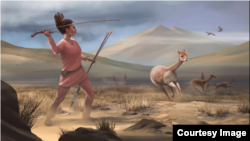In the Stone Age Americas, a woman's place may have been on the hunt, a new study reports.
The study has archaeologists rethinking ideas about gender roles in prehistoric hunter-gatherer cultures. But some scientists are not so sure about the results.
The new study appeared this month in the publication Science Advances. Archaeologists involved in the research found the remains of a young woman at a 9,000-year-old burial site in Peru. She is buried with what appears to be a complete set of big-game hunting tools: spear points, scrapers, blades and more. “Big-game hunting” means the hunting of very large animals.
Researchers could not tell the individual's sex at the place where the remains were found. “We all just assumed it was a dude” or male, said University of California Davis archaeologist Randy Haas.
Around the site, the scientists told each other “he” must have been a great hunter, Haas said. "Maybe he was a big chief or a great warrior or something," the scientists would say.
But after studying the remains back at a laboratory, scientist Jim Watson of the University of Arizona said, "I think 'he' is a 'she.'"
"It definitely was a surprise for me," Haas added.
In nearly every hunter-gatherer culture studied, big-game hunting is done almost always by men. Scientists had guessed that, for the most part, that is how it has always been.
So, was this a special case? Or were prehistoric women hunters more common than thought?
These are hard questions to answer because these kinds of sites are hard to find.
"You don't just stumble across a burial like this every day," Haas said.
So, the researchers decided to look at published records from 50 years of past digs across North and South America.
They found that, out of 429 sets of remains, 16 males and 11 females were buried alongside big-game hunting gear. The numbers are not very different.
However, scientists in those studies did not identify many of these women as hunters. Haas notes that at some other sites, the tools were described not as hunting tools but as tools for preparing food or clothing, which were considered women's work.
In one case, a researcher questioned DNA results that identified the person as female just because the remains were found with hunting tools.
Sexism could be affecting such studies and results, Haas said.
Still, a lot can happen to a burial site in 9,000 years. Remains break down, and sex gets harder to identify. Also, objects found near an individual may not have been there when the body was buried. Of the 11 females found with hunting gear, scientists found the sex and connection with the tools for only three of them, including the one Haas’ team found.
Archaeologist Ben Potter is with the Liaocheng University Arctic Studies Center in China. He said he does not believe the new study should affect “the extensive data on hunter-gatherer sexual division of labor.”
Other experts described the study as compelling.
Archaeologist Bill Hildebrandt said the study does a “good job” of showing that gender roles at the time may have been less official than in later times. Hildebrandt is with the Far Western Anthropological Research Group in California. He has studied an 8,000-year-old culture in Southern California that did not seem to have especially strong gender roles.
Looking at more recent hunter-gatherer cultures, "we would think that there wasn't much change in how men and women interacted with one another," Hildebrandt said. "But when you're willing to look at the old archaeological record, sometimes you find things you don't expect."
"That's why we do archaeology," he said, "to discover things that we didn't know."
I’m Ashley Thompson.
Steve Baragona reported this story for VOA News. Ashley Thompson adapted it for Learning English. Bryan Lynn was the editor.
________________________________________________________________
Words in This Story
archaeologist - n. a scientist who studies past human life and activities by studying the bones, tools, etc., of ancient people
gender - n. the state of being male or female; sex.
role - n. the part that someone has in a family, society, or other group
site - n. a place that is used for a particular activity
assume - v. to think that something is true or probably true without knowing that it is true
stumble (upon) - v. to find or learn about something unexpectedly
compelling - adj. very interesting : able to capture and hold your attention
We want to hear from you. Write to us in the Comments Section, and visit our Facebook page.









